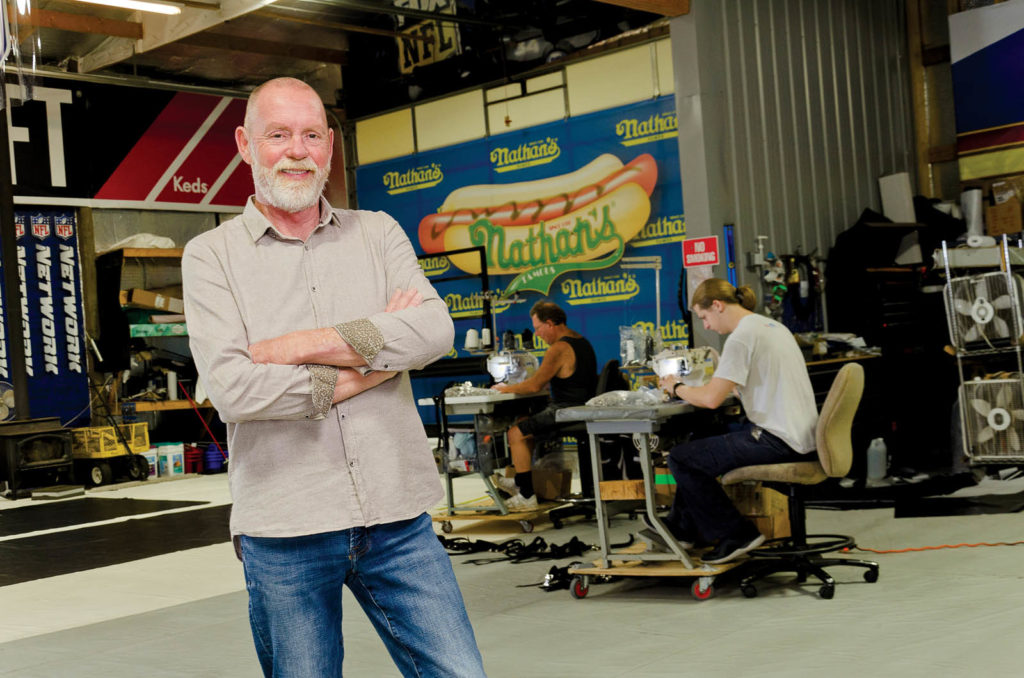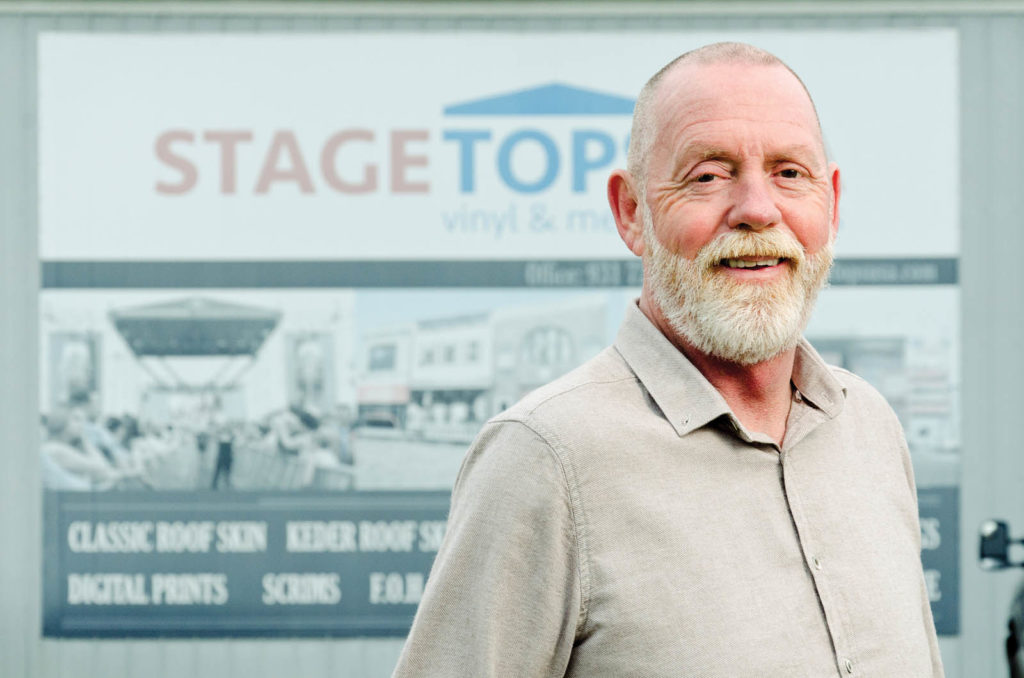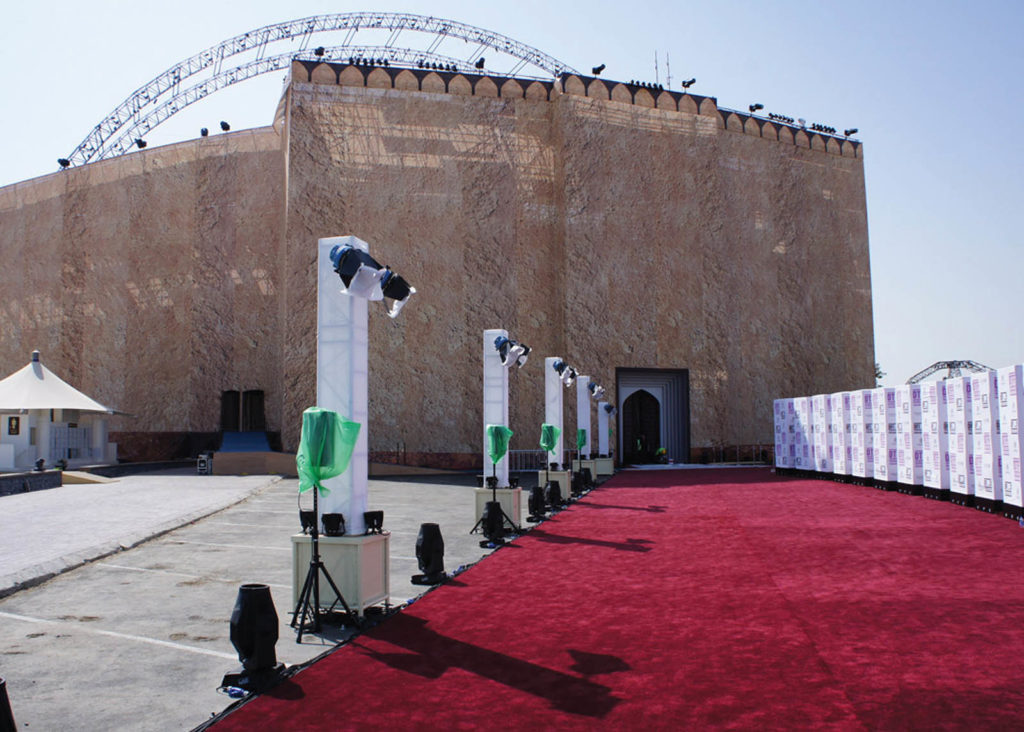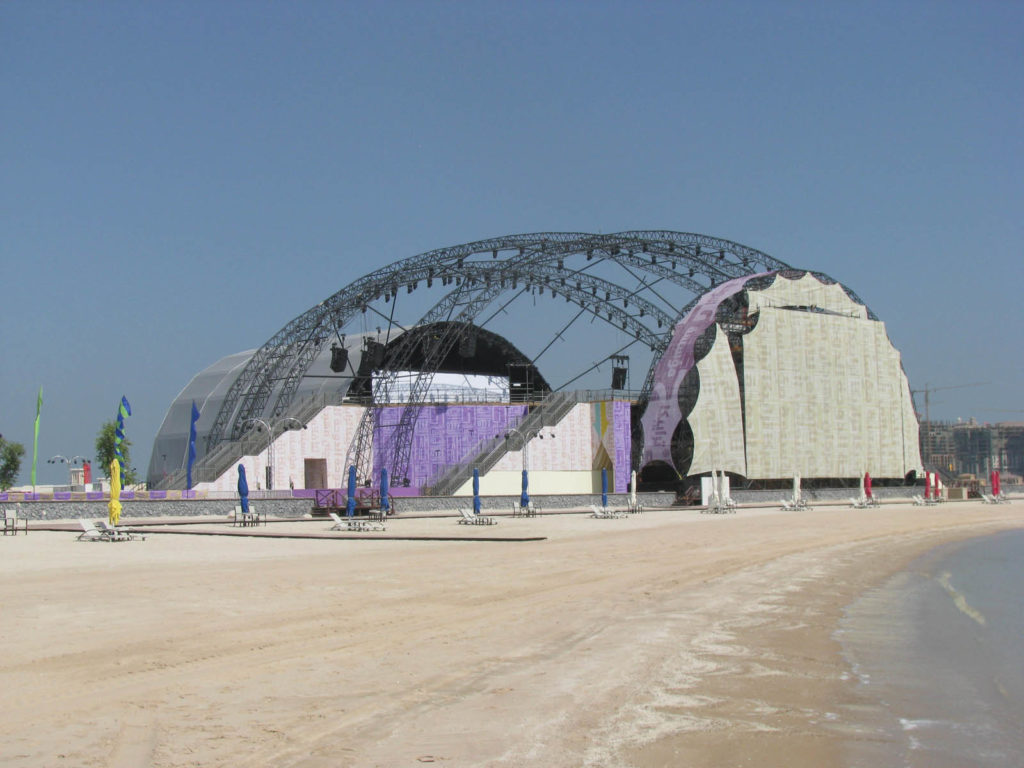by Jill C. Lafferty
“Everything is visual today,” says Kevin Greenwood, owner/CEO of Stage Tops USA, a Manchester, Tenn.-based company that manufactures and installs roof skins, wind walls, stage scrims and other fabric projects for major live events around the world. “[My clients] want to be seen. The bigger the better. They want to put graphics on it. The stage, all the live broadcasting sets, they want to be out there in the elements.”

If you’ve ever scored tickets to a major outdoor music festival or sporting event, or just watched one on TV, you’ve seen Greenwood’s work. When this interview was conducted in early February, Greenwood had just returned home from covering nine structures at Super Bowl LIV in Miami, Fla. At the same time, Stage Tops was working on projects for the Oscars among other high-profile events.
“From what I know, there is no company out there that can support a job on location like I do,” Greenwood says. “When we build it, we go with it. We put it in or direct them how to put it in.”
That Greenwood has made a name for himself in show business isn’t necessarily surprising. Hailing from England, he has worked in the entertainment industry since he was a teenager, first as a roadie and later touring internationally as a DJ. But after landing in Los Angeles in the 1980s, he found himself working for an awning manufacturer. He figured out quickly that this wasn’t his dream gig, but it did open his eyes to the possibility of doing similar work for the entertainment industry. Through personal connections with set decorators, he started supplying awnings, floor coverings, shades and other fabric products to television and movie productions.
“Then I hooked up with a staging company and got an offer to make some roof skins,” he says. “I thought, ‘Well, why don’t I try to do it myself?’ I started my own company.”
Greenwood founded what he originally called World Show International in the early 1990s, changing the name to Stage Tops USA in 1996. The early days involved “a lot of banging on doors.”
“Word of mouth was key,” he says. “Persistence. A lot of people like the one-on-one. Today people just send bulk emails out and don’t follow up. I used to call people—I still do today, but now the role has reversed. Now more people call me, because I’ve been doing it for such a long time.”

Tennessee calling
Greenwood built up his business in Los Angeles, hiring employees and eventually working out of three rented buildings. But between the cost of doing business in Southern California, the trend of production work moving to Canada, and more and more live events moving indoors (LA’s Staples Center opened in 1999), Greenwood began to feel like California was changing before his eyes and he needed to get out. Then came the terrorist attacks of Sept. 11, 2001.
“Before Sept. 11, I could tell you what was going to come in, what jobs we were going to be doing,” he says. “But when that happened, a lot of the shows got canceled, straightaway knocked out. The world had changed within days. So I had to rethink how I was going to do this because I had employees depending on it. People didn’t want to be spending any money. It was a bit of a hard time. It took some time to recover from that.”
Greenwood began looking east, to locations where land was less expensive and more live events were being produced. Through his work on one of those events, the Bonnaroo Music & Arts Festival near Manchester, Greenwood found a new home base for Stage Tops USA where he could own his facilities and be near the Nashville music scene, while traveling all over the world for installations.
Never say never
In the last decade, the music festival industry has become big business. Billboard magazine estimates that 32 million people attend music festivals in the U.S. each year, and in 2017, Coachella became the first recurring music festival franchise to earn more than $100 million. Greenwood doesn’t think the market has peaked yet.
“I think it’s still on an upward swing, because everyone wants to get into it,”
he says. “There’s lots of money to be made if you do it right, but then it can also be a disaster.”
Among the potential disasters are injuries and deaths of installers and event attendees, especially due to severe weather events. Greenwood takes safety seriously. “I’ve spent years and years on the road with the guys who are actually building it, not the person who’s paying the bill,” he says. Fortunately, the events industry is becoming more safety conscious. When he’s presented with a design that won’t work, his approach is to propose one that will.
“Never say it can’t be done,” he says. “Anything can be done. You just have to look at it a different way. Often their ideas are bigger than their budgets.”
Greenwood encourages his clients to opt for keder roof structures, where individual panels are fed into aluminum tracks, resulting in no friction between the fabric panels and the truss. It may cost a little more, but it’s safer, easier and more labor efficient. Because of the size of the company’s projects and the amount of work done on location, he hasn’t seen the need to invest in automated technology and equipment, and he prefers to outsource the digital printing. “We’re still old school and I’m trying to keep it that way,” he says. “Modern technology is great, but it’s also a hindrance. Too many people rely on a computer. I still draw with my scale ruler.”
He says his biggest business strength is his honesty. And while he may be surrounded by fame and fortune, he credits his upbringing for his ability
to stay grounded.
“I always was taught by the people around me to never forget where you’ve come from. That’s very important,” he says. “Treat people with respect. Be honest and be yourself. Don’t make out that you are something that you are not.”
Greenwood extends that philosophy to employee management. Currently,
the company has 15 employees, including a couple based in Europe.
“It’s not all about the bottom line at the end of the day,” he says. “You need the people around you. Without them you are nothing. People forget themselves when they start seeing the money.”
Reality check
If being paid to be on location at some of the biggest events around the world sounds glamorous, Greenwood is quick to describe the reality of working on live events.
“You devote your life to it,” he says. “It’s not a thing where you can just have
a vacation. There’s always something going on all over the world, all over the country. Just because it’s Christmas doesn’t mean it stops. This year I had Christmas Day off, that was it. Long hours, and it does affect your family life. Take the Super Bowl, for instance. We were coming in at 4 in the morning until 10 or 11 at night every day. No weekends off.”
Despite the travel and long hours, he says that he loves the challenges his clients send his way and that he has a good life at the helm of a unique company.
“I’m honored to be a part of this crazy industry and to know the people I’ve known over the years,” he says. “I just love what I do.”
Jill C. Lafferty is senior editor of Specialty Fabrics Review.
SIDEBAR: Q&A
What are the biggest challenges of working in the live events industry?
Timeline and weather, always. When it comes to, for instance, the Super Bowl [LIV in Miami], we had one month to pull everything off, and we were covering nine structures. I was there for 15 days. You pull your hair out because every structure is custom. Each one was different; nothing was the same. My shop pulled many long hours, and after a long day we get in a van and drive down there, because we have stuff to take down with us at the last minute. And, of course, you spend time on location, putting them in, making sure everything is good and doing last-minute tweaks.
SIDEBAR: Snapshot

Big panels for the big screen
Stage Tops USA manufactures and installs fabric products for the biggest and most high-profile events around the world. The work the company did for the Doha Tribeca Film Festival in Qatar in 2011 and 2012 exemplifies the company’s capabilities on a world stage. For those events, Kevin Greenwood, owner/CEO of Stage Tops, and three employees worked on-site for nearly 60 days to cover multiple structures, including an entrance structure that measured 150 feet wide and 200 feet tall. To accomplish the task, Greenwood shipped containers of equipment and fabric to Qatar, including Verseidag vinyl, setting up a workshop on the road. “Because of the size of the structure, we had to go there and build on location because there were a lot of unknowns,” he says. “It was a challenge due to the size and the timeline we had on it. I think to date that has to be the biggest structure we’ve ever covered. There was nothing small about it.”

 TEXTILES.ORG
TEXTILES.ORG


